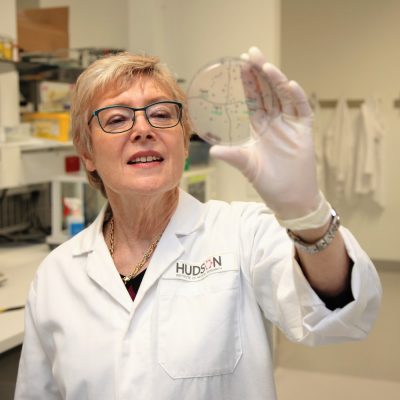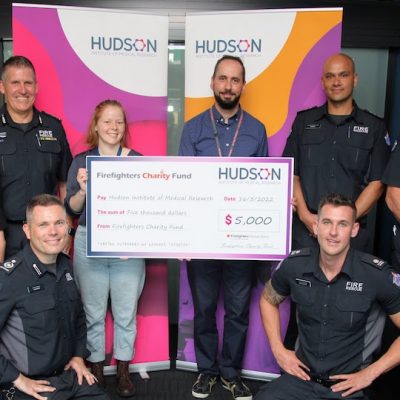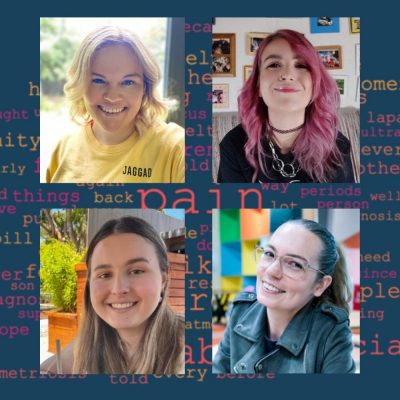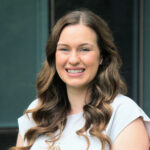Kirstin’s stillbirth story
By Rob Clancy, staff writer
Turning an experience of stillbirth into a life’s work
At the age of 20, on a gap year from her Bachelor of Science studies, Kirstin Tindal unexpectedly became pregnant. Kirstin shares her stillbirth story to help others.

Around the 22 weeks mark she was aware that something was amiss, but couldn’t get an appointment with her specialist for another two weeks.
As is so often the case, this expectant mother’s intuition sadly proved correct, and during an ultrasound procedure she witnessed her unborn daughter’s final heartbeats.
Two days later Kirstin’s stillborn daughter Aurora was born.
Preventing stillbirth
That moment marked both an ending and a beginning, and eight years later, Kirstin is working toward her PhD at Hudson Institute, on a project she hopes will save other women from the pain she endured.
“Every day in Australia about six babies are stillborn, and that figure has not improved for 20 years,” Kirstin says.
“If my research could prevent one stillbirth it would be the ultimate dream goal of my career.”
Turning an experience of stillbirth into a purpose
Largely as a result of her experience – Kirstin switched her studies from zoology to genetics and she’s now studying menstruation as an epidemiological indicator of birth outcomes and fertility.
She’s also a new mother, with two-month-old Cameron keeping her busy. But thoughts of her research, and Aurora, are never far away.
It is an area she’s passionate about and it’s what attracted her to Hudson Institute.
“I would like to see menstruation more widely recognised as an important clinical resource,” she says. “Too often women’s menstrual issues are not even considered as a significant part of their medical history.”
Kirstin’s PhD project involves collecting women’s stillbirth stories of their menstrual history and looking for connections to birth outcomes and fertility issues.

Advocacy for stillbirth
Away from work she is also an enthusiastic advocate for women who have experienced stillbirth and the many challenges it can create. Even something as seemingly positive as Mother’s Day can be a traumatic time.
“When you feel like you’ve lost your motherhood, then there’s this special day celebrating amazing mothers.”
“Being able to turn my experience of stillbirth into a purpose is a really positive thing.”
With baby Cameron by her side, Kirstin is looking to the future without forgetting the past – it’s her way of honouring Aurora.
“My experience, from losing a child to going through another pregnancy, was very nerve-wracking, but cathartic. Thanks to the generosity of those who fund our research, I hope to make a real difference to the lives of countless mothers to come,” she says.
Transforming stillbirth understanding
And, it seems that Kirstin Tindal is in the best possible place to conduct her research, with her PhD supervisor, Dr Miranda Davies-Tuck, excited to join her, working to transform understanding of the origins of stillbirth.
Among an impressive list of achievements, Dr Davies-Tuck’s impact extends as far as changing the way thousands of Australians give birth every year.
Dr Davies-Tuck’s research established that women of South-Asian origin (India, Pakistan, Bangladesh and Sri Lanka) run a higher risk of stillbirth at the end of pregnancy. The rate of stillbirth at 39 weeks was equivalent to what it is for the rest of the population at 41 weeks.
She then changed clinical practice to offer earlier monitoring for women of South- Asian background to identify babies at risk of stillbirth. Evidence of fetal distress was observed in ~10 per cent of women, triggering earlier intervention. As a result, significantly, rates of stillbirth among this group have fallen by two-thirds.
Preventing preterm stillbirth
Dr Davies-Tuck is now focusing her attention on better understanding and preventing preterm stillbirths. “Current approaches to reduce stillbirth focus predominantly on care at the end of pregnancy and while gains are being made with reducing late stillbirth, 85 per cent of stillbirths actually occur in the preterm period,” she says.
“Discovery research focuses almost exclusively on the role of the placenta in stillbirth. However, the underlying origins of poor placental function, which underpin the most common causes for stillbirth, remain poorly understood.”
Following the award of a grant of $84,000 from Stillbirth Foundation Australia, Dr Davies-Tuck is now working to uncover novel early drivers of stillbirth and critical steps that occur prior to the placenta forming, and will look at how menstruation may be used as a diagnostic tool for pregnancies at risk of stillbirth.
Hudson News Winter 2022
In this article
About Hudson Institute
Hudson Institute’ s research programs deliver in three areas of medical need – inflammation, cancer, women’s and newborn health. More
Hudson News
Get the inside view on discoveries and patient stories
“Thank you Hudson Institute researchers. Your work brings such hope to all women with ovarian cancer knowing that potentially women in the future won't have to go through what we have!”











